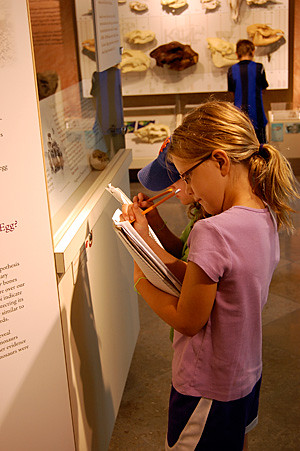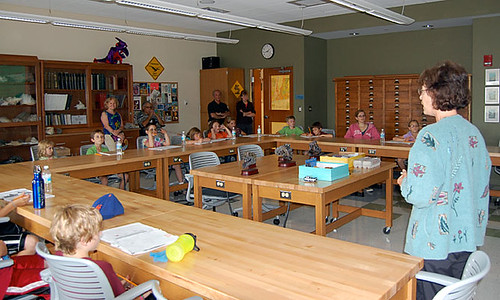 “It’s hot and humid out there today,” geology professor Connie Soja told a classroom full of students this July. “It feels like the Mesozoic out there.”
“It’s hot and humid out there today,” geology professor Connie Soja told a classroom full of students this July. “It feels like the Mesozoic out there.”
In the absence of Colgate students, who are mostly off campus for the summer, Soja was presenting to students of a different ilk as she addressed the second- and third-graders attending Hamilton’s Junior Paleontologists Camp.
Pat McGill, a reading specialist at Hamilton Central School, runs the
two-week program often referred to as “dinosaur camp.”
After two weeks
of instruction from McGill and activities in their own classroom, the
campers traveled to Colgate to hear from Soja, a professional
paleontologist, and to visit Colgate’s dinosaur egg in the Robert M.
Linsley Geology Museum.
The junior paleontologists came prepared for the experience, eagerly participating in Soja’s presentation. “When you ask a question to these younger kids,” marveled Soja, “every hand in the classroom goes up! Every kid wants to answer the question.”
The campers rose to the challenge of even Soja’s most difficult questions. For instance, she displayed a picture of a Tyrannosaurus rex and asked what kind of food it ate, plants or animals. When the students answered that it was carnivorous she explained that the scientific process required they back up their hypothesis with evidence.
 |
| Young paleontologists take notes at the Robert M. Linsley Geology Museum during their visit to campus. (Photo by Jason Kammerdiener ’10) |
The campers were able to offer tooth shape, fossilized stomach contents, and even the dinosaur’s eye placement as evidence that it was a carnivore. Likewise, they recognized that a few features, like the dinosaur’s small forelegs, might contradict their hypothesis.
McGill started the camp, offered free to campers, in 2005 with the help of geology professor Richard April.
“Children are innately fascinated with dinosaurs,” commented April, “so we thought this would be a wonderful way for students to experience a little bit of paleontology to understand a bit more about earth and earth processes, time, animals, and extinction and what that means.”
McGill and April cooperated in locating and securing external sources of funding, receiving a grant from an old telephone company, NYNEX.
McGill also took advantage of various Colgate outreach programs to educate herself more thoroughly on the subject of paleontology so that she could teach the subject with more depth.
The camp is anything but just a summer class, however.
“Not that I don’t like what I do during the year,” said McGill, “but this is hands-on learning. I don’t need to worry as much about ‘you need to sit here. You need to stay focused.’ It’s not that kind of teaching. It’s more exploration.”
For camper Aidan Woods, such exploration is hard to narrow to a favorite subject. “I like all the dinosaurs!” he explained.
The campers’ experience also has a lasting impact. Liam Stahl, now heading into seventh grade, was one of the first junior paleontologists. His word of advice for future campers? “Pay attention. Some of the stuff you learn is really useful later. And even if isn’t, it is sometimes just good to know.”
 |
| Geology professor Connie Soja talks to campers in one of the classrooms at the Ho Science Center. (Photo by Jason Kammerdiener ’10) |